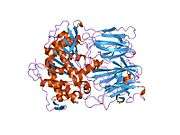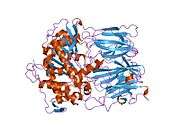Prolyl endopeptidase
| PREP | |||||||||||||||||
|---|---|---|---|---|---|---|---|---|---|---|---|---|---|---|---|---|---|
 |
|||||||||||||||||
| |||||||||||||||||
| Identifiers | |||||||||||||||||
| Aliases | PREP, PE, PEP, prolyl endopeptidase | ||||||||||||||||
| External IDs | OMIM: 600400 MGI: 1270863 HomoloGene: 2042 GeneCards: PREP | ||||||||||||||||
| |||||||||||||||||
| RNA expression pattern | |||||||||||||||||
  | |||||||||||||||||
| More reference expression data | |||||||||||||||||
| Orthologs | |||||||||||||||||
| Species | Human | Mouse | |||||||||||||||
| Entrez | |||||||||||||||||
| Ensembl | |||||||||||||||||
| UniProt | |||||||||||||||||
| RefSeq (mRNA) | |||||||||||||||||
| RefSeq (protein) | |||||||||||||||||
| Location (UCSC) | Chr 6: 105.28 – 105.4 Mb | Chr 10: 45.07 – 45.16 Mb | |||||||||||||||
| PubMed search | [1] | [2] | |||||||||||||||
| Wikidata | |||||||||||||||||
| View/Edit Human | View/Edit Mouse |
Prolyl endopeptidase (PE) also known as prolyl oligopeptidase or post-proline cleaving enzyme is an enzyme that in humans is encoded by the PREP gene.[3][4]
Function
| prolyl oligopeptidase | |||||||||
|---|---|---|---|---|---|---|---|---|---|
| Identifiers | |||||||||
| EC number | 3.4.21.26 | ||||||||
| CAS number | 72162-84-6 | ||||||||
| Databases | |||||||||
| IntEnz | IntEnz view | ||||||||
| BRENDA | BRENDA entry | ||||||||
| ExPASy | NiceZyme view | ||||||||
| KEGG | KEGG entry | ||||||||
| MetaCyc | metabolic pathway | ||||||||
| PRIAM | profile | ||||||||
| PDB structures | RCSB PDB PDBe PDBsum | ||||||||
| Gene Ontology | AmiGO / EGO | ||||||||
| |||||||||
Prolyl endopeptidase is a large cytosolic enzyme that belongs to a distinct class of serine peptidases. It was first described in the cytosol of rabbit brain as an oligopeptidase, which degrades the nonapeptide bradykinin at the Pro-Phe bond.[5] The enzyme is involved in the maturation and degradation of peptide hormones and neuropeptides such as alpha-melanocyte-stimulating hormone, luteinizing hormone-releasing hormone (LH-RH), thyrotropin-releasing hormone, angiotensin, neurotensin, oxytocin, substance P and vasopressin. PREP cleaves peptide bonds at the C-terminal side of proline residues. Its activity is confined to action on oligopeptides of less than 10 kD and it has an absolute requirement for the trans-configuration of the peptide bond preceding proline.
Prolyl endopeptidases are involved in the maturation and degradation of peptide hormones and neuropeptides.[4]
Structure
Prolyl endopeptidase is a cytosolic prolyl endopeptidase that cleaves peptide bonds on the C-terminal side of prolyl residues within peptides that are up to approximately 30 amino acids long. Only short protein residues are able to enter the active site of prolyl endopeptidase due to the distinct beta-propeller region that acts as a gating filter mechanism.[6][7]
Clinical significance
Altered PREP activity may be associated with autism spectrum disorders and various psychological diseases such as schizophrenia, mania and clinical depression.[8]
However, there is conflicting information as to the exact role that prolyl endopeptidase plays in the pathophysiology of depression, with earlier studies documenting a decreased activity of the enzyme in depressed patients, but more recent studies demonstrating that inhibition of the same enzyme actually results in alleviation of depressive symptoms.[9][10]
Some types of prolyl endopeptidase have been used in studies to decrease the propensity of gluten-containing wheat products to aggravate coeliac disease.[11] However, orally administered enzymes are potentially subject to inactivation in the gastrointestinal tract.[12]
Inhibitors
Several prolyl endopeptidase inhibitors are known,[13][14] and have been suggested as possible nootropic and antidepressant drugs.[15][16] Notable compounds include
References
- ↑ "Human PubMed Reference:".
- ↑ "Mouse PubMed Reference:".
- ↑ Vanhoof G, Goossens F, Hendriks L, De Meester I, Hendriks D, Vriend G, Van Broeckhoven C, Scharpe S (Dec 1994). "Cloning and sequence analysis of the gene encoding human lymphocyte prolyl endopeptidase". Gene. 149 (2): 363–6. doi:10.1016/0378-1119(94)90177-5. PMID 7959018.
- 1 2 "Entrez Gene: PREP prolyl endopeptidase".
- ↑ Oliveira EB, Martins AR, Camargo AC (May 1976). "Isolation of brain endopeptidases: Influence of size and sequence of substrates structurally related to bradykinin". Biochemistry. 15 (9): 1967–74. doi:10.1021/bi00654a026. PMID 5120.
- ↑ Fülöp V, Böcskei Z, Polgár L (July 1998). "Prolyl oligopeptidase: an unusual beta-propeller domain regulates proteolysis". Cell. 94 (2): 161–70. doi:10.1016/S0092-8674(00)81416-6. PMID 9695945.
- ↑ Fülöp V, Szeltner Z, Polgár L (September 2000). "Catalysis of serine oligopeptidases is controlled by a gating filter mechanism". EMBO Rep. 1 (3): 277–81. doi:10.1093/embo-reports/kvd048. PMC 1083722
 . PMID 11256612.
. PMID 11256612. - ↑ Momeni N, Nordström BM, Horstmann V, Avarseji H, Sivberg BV (2005). "Alterations of prolyl endopeptidase activity in the plasma of children with autistic spectrum disorders". BMC Psychiatry. 5: 27. doi:10.1186/1471-244X-5-27. PMC 1190193
 . PMID 15932649.
. PMID 15932649. - ↑ Maes M, Goossens F, Scharpé S, Calabrese J, Desnyder R, Meltzer HY (1995). "Alterations in plasma prolyl endopeptidase activity in depression, mania, and schizophrenia: effects of antidepressants, mood stabilizers, and antipsychotic drugs". Psychiatry Res. 58 (3): 217–25. doi:10.1016/0165-1781(95)02698-V. PMID 8570777.
- ↑ Khlebnikova NN, Krupina NA, Kushnareva EY, Zolotov NN, Kryzhanovskii GN (2012). "Effect of imipramine and prolyl endopeptidase inhibitor benzyloxycarbonyl-methionyl-2(S)-cyanopyrrolidine on activity of proline-specific peptidases in the brain of rats with experimental anxious-depressive syndrome". Bull Exp Biol Med. 152 (4): 409–12. doi:10.1007/s10517-012-1540-z. PMID 22803098.
- ↑ Stepniak D, Spaenij-Dekking L, Mitea C, et al. (Oct 2006). "Highly efficient gluten degradation with a newly identified prolyl endoprotease: implications for celiac disease". Am J Physiol Gastrointest Liver Physiol. 291 (4): G621–9. doi:10.1152/ajpgi.00034.2006. PMID 16690904.
- ↑ Fuhrmann G, Leroux JC (May 2011). "In vivo fluorescence imaging of exogenous enzyme activity in the gastrointestinal tract". Proc. Natl. Acad. Sci. U.S.A. 108 (22): 9032–7. doi:10.1073/pnas.1100285108. PMC 3107327
 . PMID 21576491.
. PMID 21576491. - ↑ Jarho EM, Venäläinen JI, Poutiainen S, et al. (March 2007). "2(S)-(Cycloalk-1-enecarbonyl)-1-(4-phenyl-butanoyl)pyrrolidines and 2(S)-(aroyl)-1-(4-phenylbutanoyl)pyrrolidines as prolyl oligopeptidase inhibitors". Bioorg. Med. Chem. 15 (5): 2024–31. doi:10.1016/j.bmc.2006.12.036. PMID 17215128.
- ↑ Kánai K, Arányi P, Böcskei Z, et al. (December 2008). "Prolyl oligopeptidase inhibition by N-acyl-pro-pyrrolidine-type molecules". J. Med. Chem. 51 (23): 7514–22. doi:10.1021/jm800944x. PMID 19006380.
- ↑ Morain P, Boeijinga PH, Demazières A, De Nanteuil G, Luthringer R (2007). "Psychotropic profile of S 17092, a prolyl endopeptidase inhibitor, using quantitative EEG in young healthy volunteers". Neuropsychobiology. 55 (3–4): 176–83. doi:10.1159/000107070. PMID 17700042.
- ↑ Khlebnikova NN, Krupina NA, Bogdanova NG, Zolotov NN, Kryzhanovskii GN (January 2009). "Effects of prolylendopeptidase inhibitor benzyloxycarbonyl-methionyl-2(S)-cyanopyrrolidine on experimental depressive syndrome development in rats". Bull. Exp. Biol. Med. 147 (1): 26–30. doi:10.1007/s10517-009-0458-6. PMID 19526123.
- ↑ Yoshimoto T, Kado K, Matsubara F, Koriyama N, Kaneto H, Tsura D (December 1987). "Specific inhibitors for prolyl endopeptidase and their anti-amnesic effect". J. Pharmacobio-dyn. 10 (12): 730–5. doi:10.1248/bpb1978.10.730. PMID 3330562.
- ↑ Tarragó T, Kichik N, Claasen B, Prades R, Teixidó M, Giralt E (August 2008). "Baicalin, a prodrug able to reach the CNS, is a prolyl oligopeptidase inhibitor". Bioorg. Med. Chem. 16 (15): 7516–24. doi:10.1016/j.bmc.2008.04.067. PMID 18650094.
- ↑ Toide K, Shinoda M, Miyazaki A (1998). "A novel prolyl endopeptidase inhibitor, JTP-4819--its behavioral and neurochemical properties for the treatment of Alzheimer's disease". Rev Neurosci. 9 (1): 17–29. doi:10.1515/revneuro.1998.9.1.17. PMID 9683325.
- ↑ Jalkanen AJ, Puttonen KA, Venäläinen JI, Sinervä V, Mannila A, Ruotsalainen S, Jarho EM, Wallén EA, Männistö PT (February 2007). "Beneficial effect of prolyl oligopeptidase inhibition on spatial memory in young but not in old scopolamine-treated rats". Basic Clin. Pharmacol. Toxicol. 100 (2): 132–8. doi:10.1111/j.1742-7843.2006.00021.x. PMID 17244263.
- ↑ Morain P, Lestage P, De Nanteuil G, Jochemsen R, Robin JL, Guez D, Boyer PA (2002). "S 17092: a prolyl endopeptidase inhibitor as a potential therapeutic drug for memory impairment. Preclinical and clinical studies". CNS Drug Rev. 8 (1): 31–52. doi:10.1111/j.1527-3458.2002.tb00214.x. PMID 12070525.
External links
- prolyl endopeptidase, human at the US National Library of Medicine Medical Subject Headings (MeSH)
- Prolyl Endopeptidase entry at the National Center for Biotechnology Information















